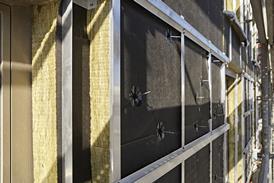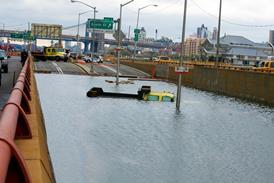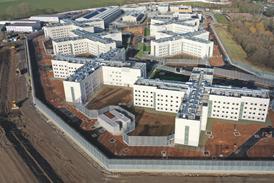The HDR-04MP network DVR from Hunt Electronic
A frustrating product - but fixable!
What our experts say …
Convergence was a popular buzzword in consumer electronics circles a few years ago, signifying the coming together of various digital technologies. The effects of convergence have been widely felt and clear to see with a raft of products that combine digital technologies that communicate with one another. Devices such as MP3 players, digital still cameras, camcorders and PCs spring immediately to mind.
A similar convergence of digital technologies is now taking place in video surveillance, albeit on a more modest scale and at a slower pace. One of the first examples is the marriage between video surveillance cameras and computer networks in the shape of network cameras.
After a somewhat shaky start it now looks as though these two previously disparate techno-logies have a rosy future together and we can look forward to new and even more interesting collaborations, such as the Hunt Network DVR.
Sending live video images over a computer network is not exactly a new idea and a network DVR is a logical progression from a network camera. But it has the potential to solve an old problem with DVRs, namely a way of exporting and archiving images. Though sadly it hasn’t been given the priority it deserves in this instance – but more about that in a moment.
Unlike a lot of current DVRs, the Hunt machine is not PC-based; it uses a proprietary chipset on a custom-designed mainboard to process and record four video channels simultaneously on a 120Gb hard drive, mounted in a removable caddy. There is room inside the case for a second fixed drive with a capacity of up to 120Gb, bringing the total to 240Gb. This provides a maximum recording time of 7,360 hours at the slowest recording rate (one field per second) and lowest quality setting. This drops to around 36 hours at the fastest ‘real-time’ rate of 25fps and best picture quality mode.
It’s a simplex system – fairly unusual these days – and there is no audio recording option. But it does use industry-standard M-JPEG compression to record images, either continuously, at scheduled times or in response to an internal or external alarm activation.
The internal alarm is motion triggered but it is a rather crude system with a coarse sensitivity adjustment and no facility mask out areas to minimise spurious activation.
The networking feature works on any PC with standard browser software such as Internet Explorer with an Active X ‘plug-in’ that is down-loaded from the DVR when a connection is established. This allows an operator on a net-worked PC to remotely view live video, play back and record images and access many of the DVR’s control functions.
DVRs are very good at recording video and are well on their way to replacing VCRs but, unlike tape cassettes, the medium does not lend itself to easy archiving. Various solutions have been tried, including copying stills to floppies and video recordings to an optical disk using a built-in CD/DVD writer, or making the hard drive removable, so it can be archived or transferred to a suitably equipped PC, which is one of the features of this model. Though it would have made more sense if Hunt marketed extra drives and caddies (or if they do, mention the fact somewhere in the literature ...).
The Hunt DVR’s networking capabilities point to another archiving possibility, namely a facility
to transfer recordings from the recorder to the hard disk on a networked PC. It can be done, but the designers have not made it easy or obvious, as we shall see.
Incidentally, according to Hunt, at some point it intends to add a Compact Flash card slot to this unit, which will make it a lot easier to transfer still images out of the DVR and into a PC.
No beauty
The DVR is housed inside a cream-coloured rack-mountable case measuring 55 x 432 x 321mm. It is not going to win any beauty contests, which admittedly isn’t a major concern, but the front panel design does look a tad slap-dash with a stuck-on Hunt badge and strange italicised control labelling.
The layout is very straightforward with a group of three LEDs in the top right hand corner indicating power on, record and playback modes. A bank of five buttons are used to select each of the four camera inputs or a quad display. They are also used to enter PIN codes for the rudimentary security functions.
Next to that is row of six buttons for the recording and playback functions and to the right of those are a cluster of four menu/cursor keys. On the far right is the hard disk caddy, protected by a key operated locking mechanism; two LED indicators next to the hard drive show power on and hard disk activity.
The rear panel shouldn’t frighten the horses either and from left to right there is the exhaust vent for the internal cooling fan, a nine-pin D-Sub socket for RS-485 serial comms, an Ethernet socket with activity LEDs and a bank of eight BNC sockets for video in and loop through outputs.
There are two video outputs, for a monitor or backup VCR in the shape of a BNC socket for composite video and a six-pin mini DIN for Y/C or S-Video. Next along is the Alarm connector and on the far right is the mains sockets and master on/off switch
Inside the case there’s not a lot to see, just the main board and a small handful of daughter boards responsible for the front panel controls and rear panel connections.
Spare data and power leads for the second hard drive, which mounts directly to four raised pillars on the base of the cabinet, are tied back in readiness.
Set-up & operation
The DVR is supplied with a set of rather badly translated instructions in a dual-language (English and Chinese) manual, which are just about ade-quate to get the unit up and running as a stand-alone video recorder. Additional instructions for the networking facility are on a CD-ROM, along with a simple configuration utility that needs to be used when the DVR is connec-ted to a network for the first time.
The utility automatically seeks out the DVR on a network and lets the user or installer make changes to the network settings, after which is it ready to go. The only change required on our sample was to alter the IP address, which took just a few moments.
After a power interruption – but not at initial switch on – the DVR goes into recording mode using the factory default of 15 fps multiplex recording. Security is minimal: pressing a button a set number of times locks out the controls but it’s easily overridden by cutting the power.
To access the recorder’s controls it is necessary to go into Stop mode and press the Menu button, which brings up eight options. From top to bottom they are: System Setup, Camera Setup, Record Setup, Schedule Record, Event List, HDD Management, Load Defaults and Exit.
System Setup covers alarm buzzer duration, alarm video interruption, motion buzzer, HDD password, set time/date, all of which is self explanatory. The Camera Setup menu is equally straightforward with menu items for enabling/disabling cameras, recording on/off, motion detection on/off, motion sensitivity and adjustments for brightness, contrast and hue, all of which act globally.
The one very surprising omission is the lack of any means to change or create titles for the four cameras, which are forever fixed as CH1, CH2, CH3 and CH4.
Record Setup is where you’ll find switches for multiplex or quad recording, recording frame rate (one to 25fps in eight steps), alarm recording rate (eight steps again), alarm record duration (one to 30 seconds) and record quality (four steps: low, medium, high or best).
Schedule Recording has a simple ‘daily’ timeline with 24 check boxes each of which can be set to ‘full record’, ‘no record’ or ‘alarm record’. The Event List menu does what it says on the tin and details all recorded events, triggered by alarm activation, power interruption or the start of a new recording session.
HDD Management includes switches for automatically overwriting old data when the disk is full, and a drive-full warning message. There are also indicators for master and slave drive capacity and space remaining, and master and slave formatting. The Load Defaults menu item returns the DVR to its factory fresh condition.
Normal operation, with the DVR in record mode, requires little or no intervention; the fun and games begin when you try to get the machine to replay a recording. The main problem concerns the rudimentary search facilities. In order to access a specific recording it is necessary to use the cursor keys to specify a start time and date, and it is far from intuitive.
For example, to view a recording made at 10.25 on Jun 16, 2004, involves positioning the cursor on the month display – a minimum of three presses to take it past the year display, then select the month – between one and 12 presses, then the first digit of the date – two or three presses, then the second digit of the date – up to nine presses, then the first hour’s digit, one or two presses, then the second hour’s digit and up to nine presses again, and the same again for the minutes. And since the ‘Enter’ button only increments values, if you make a mistake you have to go around and start again ...
In short, it’s quite a palaver!
But it gets worse, because the replay system has only 2x, 4x and 6x replay speeds, so if you are not within a few minutes of the target time it could mean a long wait to get to a specific event, skimming through a recording at a very sedate pace. A faster and simpler search option is need-ed, and a more efficient way of navigating the contents of the hard drives, which could contain recordings spanning several weeks.
To make matters worse, there doesn’t appear to be any way to flag, protect or archive potentially important recordings, which the DVR will eventually overwrite.
When the DVR is controlled through a network connection it should be possible to extend the range of controls using the PC’s mouse and keyboard. Instead the designers have opted to simply replicate the DVR’s front-panel controls and the only additional options concern network configuration settings and the facility to record the video stream on the PC.
This brings us back to the awkward, possibly unintentional, archiving facility mentioned earlier. In order to use it, the DVR has to be put into playback mode and the PC set to record the video stream (either a stream of still JPEGs or AVI video) by right clicking on the image.
It certainly works, but since the PC is recording re-processed video sent over a network, rather than original data files stored on the DVR, there is a marked drop in picture quality – compared with the original recordings – as the effects of compression and processing take their toll. Furthermore the procedure is unnecessarily complicated – assuming that users even discover that it exists. But it’s a step in the right direction and shows that it can be done.
Performance
In quad mode all four cameras are recorded sim-ultaneously in quad format, which ironically occupies more disk space than the more convenient ‘Mux’ or multiplex mode, where each camera image is recorded in sequence. In quad mode it is only possible to display the four-camera view whereas in Mux mode each camera channel can be displayed full screen, in addition to a quad view.
In terms of picture quality there’s comparatively little to choose between the ‘best’ and ‘high’ recording modes but there is a marked deterioration in ‘medium’ and ‘low’ modes, with a big reduction in resolution plus an increase in noise and processing artefacts. It doesn’t matter quite so much in quad mode, where each camera image only occupies a quarter of the display screen, but it is immediately noticeable in Mux mode when displaying a single camera channel.
In terms of actual quality, best and high modes compare well with other DVRs we’ve seen recently and top-end S-VHS recorders, though with significantly lower levels of picture noise. Medium and low modes are akin to VHS, on a well-worn tape with somewhat coarse, whiskery looking images. In all modes colours are cleanly resolved and the actual images are rock solid in all replay modes.
Picture quality suffers when images are viewed over a network connection with a drop in resolution and colour fidelity. But a lot depends on the source signal, and image quality from a high-end camera can still be perfectly acceptable even after it has been through the network mangle, whereas pictures from a cheap camera will start to look quite ragged under the same conditions.
Nevertheless, it is difficult not to be impressed that live real time images can be delivered more or less intact over a network, and the facility to remotely replay and locally record material helps to offset the reduction in quality. *
* Reader Service No 101 (or go to www.security-installer.co.uk/enquiries and key in 101)
What the manufacturer says ...
The HDR-04MP from Hunt electronic took advantage of the network technology application: it is the one of the first cost-effective four-channel DVRs to offer network capabilities. The Internet interface allows users to remotely control the DVR through the Internet while away from the DVR, which includes viewing live-time cameras, watching playbacks and recording.
It includes motion detection, Ethernet function, real-time display, various recording speeds and quick search by time & event. Cameras can be set up individually.
It is a complete DVR solution with one 120Gb HDD fixed in the mobile rack (removable) and one 120Gb HDD fixed internally (optional), which total 240 Gb HDD, capable of record-ing for up to 7350 hours at one field per second in multiplex mode and 2550 hours at one field per second in Quad mode. Recording quality can be user selected, which can be recorded at rates up to 25 fields per sec and recording can be continuous or event-driven.
Overall assessment
This is a frustrating product. As a standalone replacement for a surveillance/time-lapse VCR, it stacks up reasonably well, though the lack of any simple means of exporting images, other than by connecting it up to a VCR, or the ramshackle network method, is a serious flaw, and it has crude navigational facilities.
We are disappointed by the lack of camera titling facilities and a relatively low-level of security for the DVR controls. Significant event recordings cannot be protected and the motion detection system is next to useless. But the DVR recording quality is very good and the networking feature works well and could be a valuable asset for many users. This machine has enormous potential. All of the problems we've highlighted are fixable ... hopefully in a Mk 2 version!
Source
Security Installer





















No comments yet